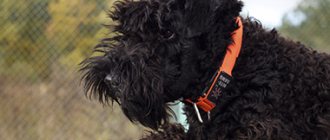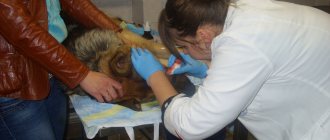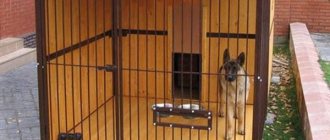Causes of shortness of breath in dogs
The condition when a dog is choking and wheezing can occur for various reasons. Sometimes this is typical for certain breeds. But in most cases, shortness of breath is a sign of pathology that needs to be treated.
The main causes of wheezing when breathing:
- Cardiogenic - circulatory disorders and cardiovascular diseases. Anemia, cardiomyopathy, acute and chronic heart failure, congenital or acquired heart disease. When the heart muscle weakens, pulmonary edema may develop.
- Respiratory - diseases and injuries of the respiratory tract. Colds, pneumonia, pleurisy, allergies, foreign body or tumor in the respiratory tract. Fracture or bruise of the chest, broken ribs, accumulation of fluid in the chest.
- Pathologies of the central nervous system - brain tumors, traumatic brain injuries, epilepsy, diabetes mellitus, metabolic disorders, electric shock, pain shock, high fever, kidney and liver diseases, obesity, severe stress.
Sometimes shortness of breath develops within 24 hours of delivery. If this symptom does not go away on its own, you need to call a veterinarian.
For reference! First, the veterinarian will examine the animal and make a diagnosis. When the cause of shortness of breath becomes known, treatment begins immediately.
If your dog wheezes, sniffles, coughs, grunts, or breathes heavily, you need to treat it
Natural predisposition of some breeds
If your dog grunts, wheezes or snores, this may be a trait of some breeds. Animals with a flattened muzzle and a flat nose cannot breathe fully. Improperly positioned soft tissue in the nose and throat can slightly choke your pet. Therefore, they constantly emit hoarse breathing with a whistle. They almost always snore in their sleep.
Several breeds are prone to shortness of breath:
- pugs;
- Pekingese;
- toy terriers;
- bulldogs;
- many miniature ornamental breeds.
These breeds are prone to serious pathologies of the respiratory system, so the health of such pets must be closely monitored and regularly visited by a veterinarian.
Sometimes even animals with a long muzzle can experience breathing problems. This happens especially often with toy terriers. In these dogs, difficulty breathing is associated with pathologies of the trachea. A healthy organ is supported by strong cartilage. If the cartilage becomes soft and flabby, then the lumen of the trachea narrows. Because of this, the dog cannot breathe normally. Spasm and swelling of the larynx occurs.
Narrowing of the tracheal lumen leads to the collapse of this organ. It is important to remember that dogs of this breed are also prone to collapsed lungs. If your toy terrier is choking and wheezing, you should immediately contact a veterinarian.
Important! There is such a condition as reverse sneezing. In most cases, it does not threaten the dog’s life, but it greatly frightens the owners. It is necessary to find out what exactly happened to the dog - shortness of breath or reverse sneezing.
Toy Terriers often develop tracheal diseases
Foreign body
If your dog wheezes when breathing through his nose, this may indicate a foreign body in the airway. A toy, branch or any other object could be stuck in the throat or nose. If you cannot pull it out yourself, you should immediately contact a veterinarian.
Allergic reaction
Many pets are prone to allergies to food, household chemicals and other substances. Allergic reactions can be very different: the dog wheezes when breathing, has drooling or a runny nose. Your pet may sniff or sniff frequently.
You need to find out which item caused the allergy and remove it away from the dog. If it is a food product, it is excluded from the diet.
Colds, tumors and other possible causes of heavy breathing and wheezing
The dog whistles with its nose and barks with a hoarse voice in case of colds, inflammatory, cardiovascular and oncological diseases. It is necessary to cure the primary disease, then the wheezing will stop.
Flat-faced animals are prone to panting
Cough as if choking upon swallowing a foreign body
Unfortunately, even the most responsible dog breeder is not able to keep an eye on the pet and protect it from swallowing foreign objects. This problem especially often arises on the street when the dog is walking without a leash. In most cases, when a foreign body is swallowed, the dog itself copes with the problem by coughing up.
The dog is trying to cough up something
But sometimes the dog can eat a bone or object, which subsequently clings to the mucous membrane. This can be understood by the following symptoms:
- the occurrence of a prolonged, paroxysmal cough, from which the puppy seems to be choking;
- When coughing, the dog makes an effort to spit out the disturbing object. Sometimes it may be accompanied by blood and foam;
- hoarseness, breathing becomes difficult;
- drinking and food do not arouse the dog's interest.
So what should you do if your dog is choking and coughing? You can try to remove the item yourself. To do this you need:
- Hold the dog's muzzle and open its mouth with your hands.
- Examine your throat carefully. If the foreign object is located shallowly, you can try to remove it with tweezers.
- If the object is not noticeable in the throat, but all the symptoms indicate its presence, and the dog continues to wheeze and grunt, then you should show it to the veterinarian. If you do not seek help from a specialist in time, complications may develop in the form of emphysema and inflammatory processes in the internal organs.
Important! It is permissible to remove an object yourself only in emergency cases, when it is not possible to contact a veterinarian. This is due to the risk of causing even more harm to the dog due to lack of experience.
Examination of a dog's oral cavity when coughing
Signs characteristic of shortness of breath
To understand why your dog is breathing hoarsely, you need to remember the main signs of shortness of breath. At the first symptoms, you need to help your pet and go to the veterinarian.
Types of shortness of breath:
- A short inhalation and a long, heavy exhalation (expiration) - this happens with asthma and bronchitis.
- A sharp, heavy, short breath (inspiration) - pulmonary edema, injury to the chest and respiratory organs, foreign body.
- Both inhalation and exhalation are difficult (mixed type) - pneumonia, heart failure, inflammatory process.
All types of shortness of breath have extensive symptoms:
- the dog cannot breathe with its mouth closed;
- the dog wheezes as if suffocating;
- cough;
- pale or bluish tint of mucous membranes;
- the dog makes a great effort to breathe;
- whistling, wheezing;
- the dog stretches its body and spreads its front paws wide;
- At first there is severe anxiety, and then the dog becomes indifferent to what is happening.
The animal must be helped immediately, otherwise irreversible pathology and death may develop.
When choking, the dog may open its mouth and stick out its tongue.
First aid for a pet if he is choking
If the owner notices that the dog is grunting with its nose, as if it is choking, it is necessary to provide first aid to the pet, and then go to the veterinary clinic.
How to help your dog:
- Place the dog in a well-ventilated room where there are no drafts.
- Provide your pet with complete rest and do not disturb him.
- Urgently call a veterinarian at home or go to the clinic yourself.
- Give the dog suprastin for swelling. For an animal weighing 5–8 kg you will need half a tablet. The tablet must be crushed and rubbed under the tongue.
- If a dog refuses to eat or drink, you cannot force it.
- Give Gamavit injections - one injection into the large muscles on each paw. The medicine must be administered in equal doses.
- Gently massage your pet's chest, abdomen, ears and back.
- You can give an injection of potassium chloride. Depending on the size and weight of the animal, from 3 ml to 15 ml of medication is drawn into the syringe and injected very carefully and slowly.
- If necessary, you can do a closed heart massage if the owner knows how to do it.
At the veterinary clinic, the doctor may put an oxygen mask on your pet or perform artificial ventilation. Most likely, a sick dog will need surgery.
The mucous membranes of the mouth turn pale or blue
What to do if your dog is choking
Of course, the responsible owner is interested in the question, if the dog is choking and cannot clear its throat, what to do. In most cases, dogs cope with coughing on their own, but only if the attack is not severe. With prolonged coughing, the animal may begin to choke, and this cannot be done without the help of the owner. You can avoid suffocation by doing the following:
- During an attack of reverse sneezing, your pet should be helped to swallow the accumulated drool and take a deep breath. For this purpose, he needs to pinch his nose and run his palm over his throat several times until the saliva passes;
- it is necessary to help the pet take the correct position, namely, turn it over so that the head is lower than the body and limbs. After this, you can shake it several times and lightly tap on the back;
- If the dog stops breathing, then it is immediately necessary to ensure a flow of oxygen to the respiratory organs and perform a heart massage.
Important! After the attack has passed, the animal must be taken to the veterinarian to avoid a recurrence of the condition.
First aid if a dog chokes on a bone
When to contact a veterinarian
If your pet is choking, you should contact your veterinarian as soon as possible for any symptoms.
It is necessary to urgently treat your dog if it develops life-threatening symptoms:
- the dog is trembling (runny nose, wheezing, heavy breathing);
- mucous membranes have turned blue or pale;
- the tongue falls out of the mouth;
- convulsions;
- heart attack.
You need to calm your pet down and call a doctor immediately. If the dog is not helped in time, it may suffocate.
Important! Dyspnea (difficulty breathing) should not be confused with tachypnea (fast but not heavy breathing). Tachypnea often develops after running and physical activity.
The pet should be placed in a cool place and given medicine
What to do if foam appears
Foaming when coughing is a symptom of kennel cough. The attack is accompanied by a urge to suffocate, and vomiting often occurs. At the end, the dog begins to belch white foam.
Additional symptoms are:
- increased body temperature;
- apathy;
- refusal to eat;
- swelling of the tonsils and nasal discharge.
Individuals under 2 years of age are more susceptible to this disease. The disease is transmitted by airborne droplets, in addition, the source of the disease can be brought home on the sole of a shoe.
The disease can also occur without infection, namely when a foreign object enters the respiratory system. So, the dog will try to cough out what it inhaled. But if the object is stuck deep, then only foam, mixed with blood, will be coughed up.
Note! At the end of the attack, it is recommended to give the dog something to drink.
Diagnostic methods
Shortness of breath and heavy breathing is not a disease, but a sign of illness or injury. It is important to know which factor caused shortness of breath. Therefore, first of all, the veterinarian conducts diagnostics to understand why exactly the dog is suffocating. To do this, they do an X-ray, ECG, ultrasound, MRI, general blood test, check for parasites and other procedures.
If a foreign body enters the respiratory tract, the doctor must remove it and then, if necessary, perform artificial ventilation of the lungs.
In case of head or chest injury, surgery is performed, followed by a comprehensive course of treatment. If fluid has accumulated in the chest, the veterinarian will remove it. This operation is called thoracentesis.
Colds and inflammatory diseases are treated at home with prescribed medications. For anemia, a therapeutic diet is also prescribed. The drugs used are diuretics, analgesics, immunostimulants, and anti-inflammatory drugs.
Preventive measures
It is necessary to urgently show the dog to the veterinarian.
To prevent shortness of breath, it is recommended to provide the dog with good care. Food should include all vitamins and minerals, especially iron and calcium. You need to check your heart function often and protect your pet from infectious diseases.
If the breed is prone to shortness of breath, you should regularly visit the veterinarian and monitor the condition of the respiratory tract. If a dog has serious illnesses or injuries to the central nervous system (for example, epilepsy or concussion), you must carefully monitor its well-being and follow all the veterinarian’s prescriptions.
When walking, do not tighten the collar or harness on the dog's neck too tightly. A tight and tight collar will constantly suffocate your pet. This will inevitably lead to breathing problems.
Important! The dog needs a soft and elastic collar that does not put pressure on the neck.
You need to take care of the puppy’s health from the first days of its life, then the adult dog will always feel good. You need to feed your furry pet well and choose a comfortable collar for it.











